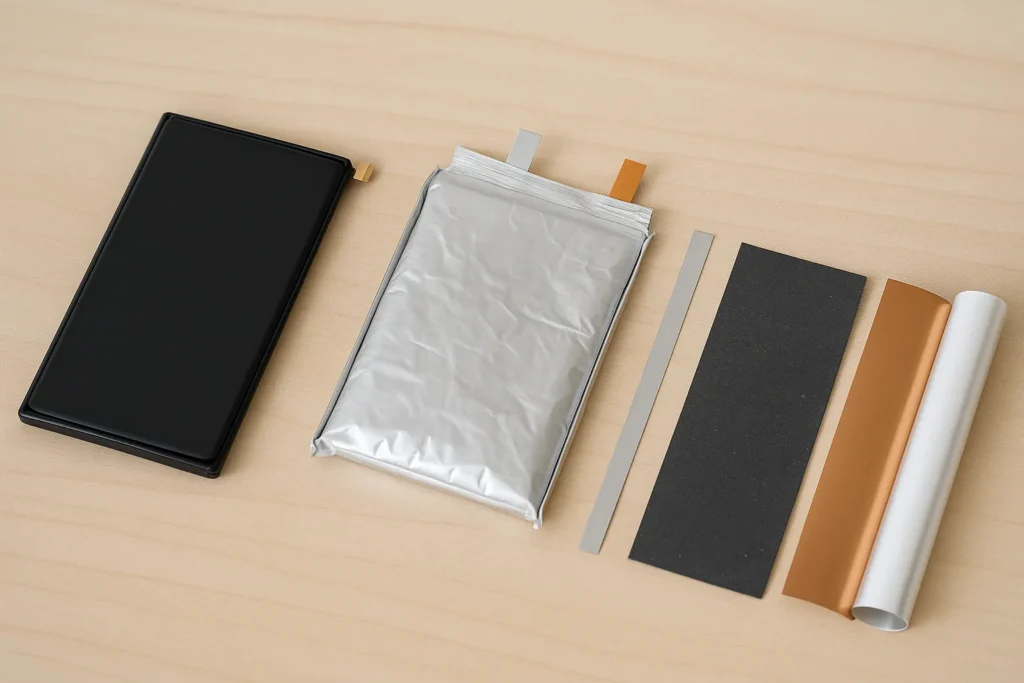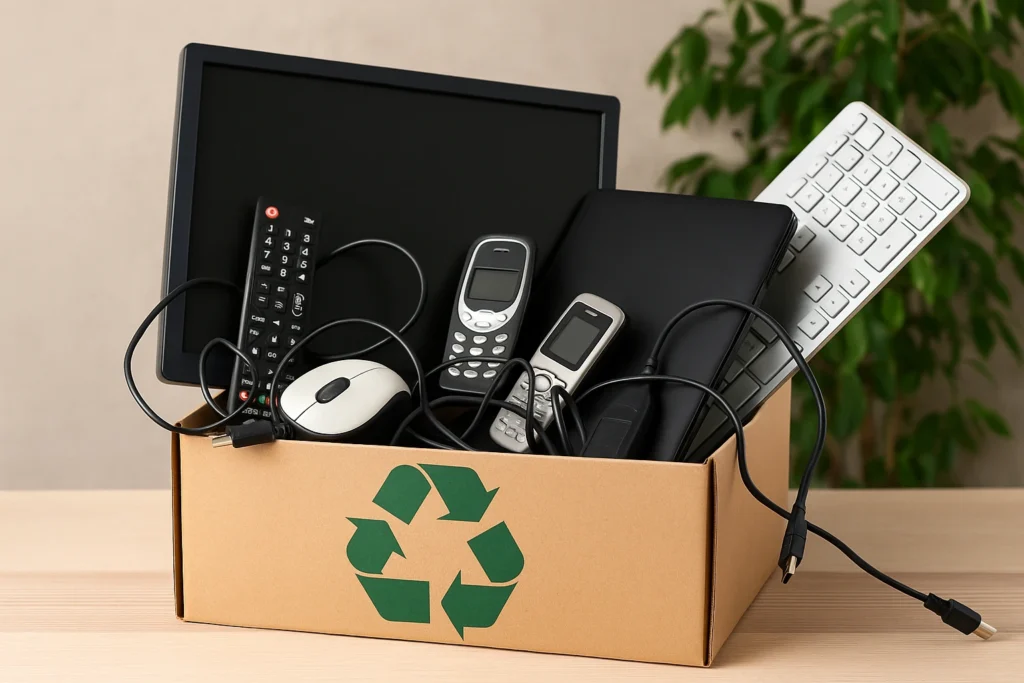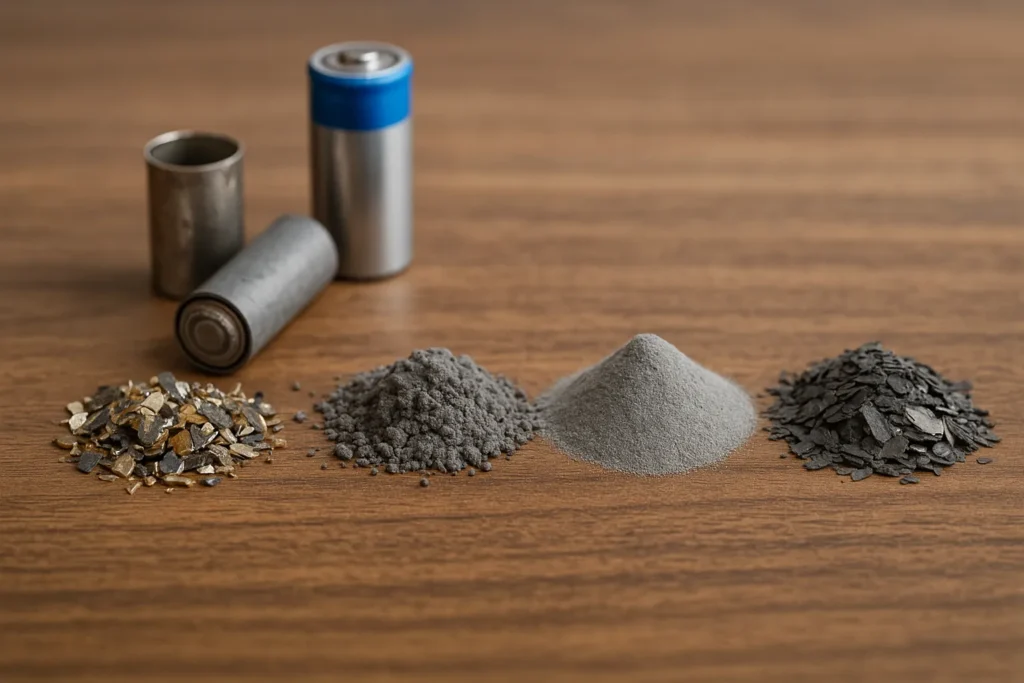Do you have a drawer full of old phones, dead torches, and random laptop batteries you never sort through? That clutter can be a fire risk, harm the environment, and waste valuable materials.
It’s because most of these rechargeable devices use lithium-ion batteries, which can be hazardous when damaged or exposed to heat.
And if you throw them away, you’ll be contributing to the fast-growing e-waste problem worldwide. In 2022 alone, we produced over 62 million tonnes, much of which ends up in landfills or is burned, releasing toxic chemicals.
So what’s the solution? It’s important to be well-informed about the batteries you use.
In this guide, we’ll share what’s inside these batteries, why they’re risky, and how smart recycling protects health, the environment, and recovers valuable materials.
First, let’s look at what’s actually inside a lithium-ion battery.
What’s Inside a Lithium-Ion Battery?

A lithium-ion battery is made up of lithium, cobalt, nickel, manganese, graphite, and an electrolyte that carries an electric charge.
Lithium-ion batteries aren’t like the disposable AAs you toss in the bin after they die. They’re rechargeable, powerful, and built to last through hundreds of charge cycles. But all that stored energy means they need careful handling.
We’ll explain where you find them and what sets them apart from other types, to make it easier to handle and recycle them safely.
Common Uses and Battery Types
Your mobile phone, laptop, cordless drill, and electric car all run on lithium-ion batteries. On top of that, e-bikes, medical devices, and power tools use them too. Here’s how they compare to other options:
- Lead-acid batteries are heavier and less efficient, though they cost less upfront.
- Nickel-metal hydride cells sit somewhere in the middle for performance.
- Alkaline batteries aren’t even rechargeable, so they’re single-use only.
Lithium-based batteries stand out among them for their high energy density and long recharge cycles. They can go through hundreds of charges while keeping most of their capacity, which is why they’ve replaced older battery tech in most modern devices.
What’s Inside
The materials inside these batteries change depending on what they’re used for.
Lithium cobalt oxide appears in phones and laptops because it delivers high energy output. But lithium iron phosphate is safer and more stable, which makes it popular in electric cars.
Both types squeeze huge amounts of energy into small packages. The trade-off is that the concentrated power comes with real risks. The electrolyte liquid inside catches fire easily, and the lithium ions go haywire when the battery cell gets damaged.
Health Risks and Fire Hazards
Here’s where things get serious: when a battery gets punctured or crushed, the cells inside can short-circuit almost instantly. This creates intense heat and can set the flammable materials alight in just seconds. The worst part is that once started, these fires feed themselves and are very hard to put out.
The toxic fumes are just as worrying as the flames. A Scientific Reports study found that burning lithium-ion batteries releases hydrogen fluoride and other nasty chemicals that can seriously damage your lungs.
That’s exactly why proper battery recycling through official programmes is so important for protecting human health and our environment.
But what happens to all the old batteries piling up globally? The numbers tell a lot about how we’re handling this growing problem.
How to Reduce E-Waste and Improve Recycling in Your Community

Electronic waste is piling up faster than we can process it, and most people have no idea where to start with recycling. But the gap between what we throw away and what gets recycled is a problem you can fix with a few simple actions.
What counts as e-waste?
E-waste includes any item with a circuit board or battery, like mobile phones, laptops, large household appliances, and rechargeable battery packs from your power tools. Large household appliances like fridges and washing machines count too. So do medical devices, electric toothbrushes, and even solar panels with battery packs.
Basically, if it plugs in or runs on batteries, chances are it’s considered electronic waste when you’re done with it.
Gaps in knowledge and infrastructure
Want to know what’s most frustrating about all this? More than half of people don’t know how to properly recycle lithium-ion batteries, and 41% aren’t aware of the dangers of chucking them in the bin. This knowledge gap means tonnes of valuable materials end up wasted instead of being recovered.
The recycling infrastructure itself has serious shortfalls, too. Collection points are limited in many areas, and public education campaigns don’t reach enough people. Without clear guidance on where and how to recycle, most batteries still end up in landfills, even when people want to do the right thing.
What happens to a recycled battery?

Once properly recycled, batteries get pulled apart to recover the valuable stuff inside. The process separates lithium, nickel, cobalt, and graphite, which can then go into new batteries or other products. Some facilities, like Umicore, now recover over 95% of the materials from each battery cell.
This recovery process supports international agreements aimed at reducing toxic material use and preventing hazardous substances from entering the environment. Recycled materials also mean less mining, lower carbon emissions, and fewer toxic chemicals released during production.
How to do it right
First things first: grab some electrical tape or duct tape and wrap it around the terminals of your old batteries to stop short circuits. Then store them in a glass jar with a loose-fitting lid, not a metal container. The lid must be loose so pressure doesn’t build up inside.
When you’re ready to drop them off, Australia’s B-cycle programme has thousands of collection spots around the country. You’ll often find them at places like Aldi, Bunnings, and Battery World stores.
Your local council might also run hazardous waste collection days and have recycling bins at community centres.
Pro tip: Don’t let batteries sit in your collection jar for more than six months before dropping them off. The longer they hang around, the bigger the fire risk gets.
A Sustainable Future Starts With Responsible Tech Disposal
Small changes in how we handle battery waste can add up to huge improvements for our environment and resource security.
Your everyday actions make a genuine difference here:
- Store your old batteries safely with taped terminals in a fireproof container until you can drop them off.
- Take them to proper e-waste collection points like B-cycle drop-offs at Aldi or Bunnings instead of tossing them in the rubbish.
- When buying new electronics, choose products with longer battery life or ones designed with recyclable components in mind.
But the good news is that battery recycling infrastructure is expanding rapidly, with global capacity expected to increase by 50 times over the next decade.
Want to learn more about sustainable living and responsible waste management? Visit Eco4TheWorld for practical tips on reducing your environmental footprint and making better choices with everyday products.
